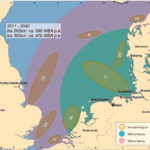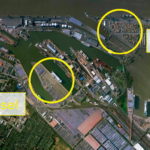The City of Bremerhaven is planning an Offshore Terminal as a heavy-load, assembly and transhipment facility for the offshore wind energy industry. The project is to be realized as a concession model.
1. Offshore wind industry branch and its perspectives
The ambitions of the German Federal Government are at a[ds_preview] very high level. By the year 2020 10.000 MW offshore power are supposed to be installed in the German North and Baltic Sea, even 25.000 MW until 2030. 15 % of Germany’s domestic homes shall be supplied by the energy, produced by wind on the North and Baltic Sea. Until today, 34 offshore wind parks are approved and many more are being planned and scheduled for the next years. The first German offshore wind park was »Alpha ventus« with twelve wind energy plants 45 km northwest of the island Borkum.
»Alpha Ventus« is a test wind park, developed and built by various players of the branch. Some of the equipment was produced in Bremerhaven, the rest at different locations throughout Europe and brought to Eemshaven in the Netherlands. In Eemshaven the components were collected and from there the sea transport to the final destination was started. This type of logistics concept was very circuitous and expensive. Right now the cost for the transport of the equipment ranges between 20 and 25 % of the whole wind park project. A centralized logistics concept would save transport distances and expensive changes of transport modes. This would not only help to save enormous amounts of money, but also to minimize economic and ecologic risks.
Over the next few years, more and more wind parks will be installed in the North and Baltic Sea. The aim of the participating companies and the logistics industry is to cut the expenses for transport and handling services and to try to develop some kind of standardization for the operational sequences. The offshore wind energy industry is a sector of exceptionally strong growth with a revenue potential that is expected to increase considerably over the coming years and decades.
2. Offshore cluster in Bremerhaven
The City of Bremerhaven is developing to become Europe’s center for the offshore wind energy industry. Owing to its favourable position on a deep waterway, its outstanding infrastructure and the targeted development of cluster structure, a number of manufacturers of wind energy components – such as Areva Wind, Repower Systems, WeserWind Offshore Construction Georgsmarienhütte and PowerBlades – have already decided to locate their production in Bremerhaven.
Over the past few years, the City of Bremen has invested many million Euro in the sponsorship of research and development as well as infrastructure development to create locational advantages of the very first rank for this new industry. Local firms have been able to expand their position considerably in the offshore market at the Bremerhaven location and have likewise invested in production facilities.
As a result, over 1,700 jobs have already been created in Bremerhaven in this branch. For example, Repower Systems and Areva Wind have each set up production capacities for some 100 offshore wind turbines per year. WeserWind Offshore Construction Georgsmarienhütte has invested in a production facility for offshore foundation structures. With PowerBlades, the company Repower Systems is operating a big production facility for the manufacture of onshore and offshore rotor blades.
Thanks to the strong offshore wind energy cluster and the margin in experience, Bremerhaven and the region around the Weser estuary are on the way to become the European hub for this fast-growing industry. In addition, the proximity to the planned wind parks in the North Sea also plays a significant role (Fig. 1). Measured from the Bremerhaven location, wind parks with a requirement of almost 300 wind turbines per year are now already within range of the transport and installation vessels. Not only German, but also Danish, Dutch, Belgian, Norwegian and British wind parks can be served from Bremerhaven. This affects the installation and the maintenance of the equipment.
3. Bremerhaven’s measurements for the offshore wind industry
Due to the extreme weights of the equipment, wind turbines cannot be handled on regular quay walls. The tripods for the wind park »Global Tech I« for example weigh 850 t per piece, and an average turbine usually weighs over 400 t. These heavy weights need a terminal infrastructure that is capable of handling such masses.
Bremerhaven has decided to build a heavy weight quay wall in the southern part of the old fishery port, the so called Labrador-Quay (Fig. 2). New heavy weight panels were constructed and installed in the quay walls by the port infrastructure management company bremenports. Two quay walls with space for two or three berths and an ability to carry seven tons per square meter were set up in direct neighbourhood to the production facilities. Since all the vessels that are calling the Labrador-Quay have to pass the sealock of the fishery port, the Labrador-Quay alone will not be able to handle the demand of the next years and decades.
For this reason the container terminal operator Eurogate decided to rent some of the area of its container terminal in Bremerhaven to RWE Innogy for the storage, pre-assembly and turnover of offshore wind energy equipment. This can only be an interim solution; the contract will run for two to three years. The handling will start in 2012. RWE Innogy will use these 400 m of quay wall to deliver the equipment for the wind park »Nordsee Ost«, 35 km north of the island Helgoland.
Additional capacities for the branch are being created on the so called ABC-Halbinsel (peninsula) in the locked area of the ports in Bremerhaven behind the new sea lock Kaiserschleuse (Fig. 3). The City of Bremen and the BLG Logistics Group have made the handling of the equipment for the wind parks »Global Tech I« and »Borkum West II« possible by rearranging certain facilities for the time during which the Offshore Terminal Bremerhaven (OTB) is not finished yet.
After the temporary use of the ABC-Halbinsel for the offshore wind energy industry, the BLG will return to use these areas for the shipping of automobiles.
4. Offshore Terminal Bremerhaven
To create a long-term solution for this industry that is not restricted by sea locks and able to meet the demands concerning storage and pre-assembly areas, Bremen and Bremerhaven decided to build a terminal for the purposes of the offshore wind energy industry primarily.
The logistics concept for Bremerhaven envisages that the components of offshore wind turbines will be produced, stored, pre-assembled and loaded onto barges, jack-up vessels and ships. The OTB is to create an important cost-cutting link between the production onshore and the installation at sea. The engineers of bremenports are working on the construction of the new terminal which will have a quay length of 500 m, enough for two to three berths. The navigable water depth will be 14.1 m. The terminal will have a size of around 25 ha to store, handle and pre-assemble offshore wind turbines (Fig. 2). For the OTB costs of around 200 mill. € have been calculated, including the compensation measures that have to be fulfilled. Bremerhaven is working on the road access of the terminal. Especially the heavy-weight track between the terminal and the production sites of the manufacturing industry will play a significant role in the activities and operations around the terminal.
The regional airport Luneort, which right now is located between the production sites and the future terminal, was part of a political discussion which ended to the disadvantage of the regional airport. The airport will be closed once the building process of the OTB starts. The air traffic will be relocated to the airport of Nordholz.
The short distance to the North Sea and the optimum use of the small weather windows as well as the avoidance of unnecessary transport and turnover processes are the main ambitions of the OTB. It finds its justification in these arguments and also in the settlement of the producing and supplying offshore industry. These companies need the terminal as a goods issue area.
5. The tendering procedure
Usually in Bremen the building and maintenance of infrastructure within the ports has always been a task of the state. On the container or automobile terminals for example, the well-known »landlord model« is being applyed: the separation between infra- and suprastructure. With the new project this will be different. The City of Bremen is planning to turn away from the model mentioned above and looking for a private investor. The OTB project is to be realized as a concession model. Bremenports has been commissioned on behalf of the City of Bremen to put the construction, the financing and the operation of the OTB out to Europe-wide public tender in a transparent and competitive bidding procedure. Bremen is going to be the concession grantor. The intention is to have the investor carry out the building, financing and operation of the OTB at its own expense, with the outlay to be refinanced through user fees. The structured bidding process was initiated in April 2011 through an announcement in the Official Journal of the European Union. In accordance with the applicable legal stipulations for public works concessions in the water, energy and transport sectors, the procedure will be oriented towards the requirements resulting from the regulations and principles of the EC Treaty. In the structured bidding process, a bidder prequalification phase is followed by two rounds of bids and negotiations to select the best commercial offer for the concession to build, finance and operate the OTB.
The concession will have a contract period of 30 years – enough time for the concessionaire to refinance the project’s costs by utilization fees. During the prequalification phase, the different interested parties are calculating their annual rate of return when developing their business models. By the end of November 2011 the awarding documents were sent out to the bidders. These are working on their first offers until early summer 2012. After the negotiations and the binding and final offer, the contract shall be signed by mid-2013.
Parallel to the concession procedure the plan approvel procedure is being carried out by environmental experts of bremenports. The inauguration of the OTB is supposed to be in 2015.
6. Conclusions
The offshore wind energy industry has a very high potential to become the leading source of renewable energies over the next years and decades. Bremerhaven has developed into one of the central locations of this branch in Europe and profits of the short distance to the open North Sea, the final location where the wind parks are being erected. The OTB will be the missing link in this chain to accelerate the developments and to save enormous logistic costs for transport and handling.
Stefan Färber






















